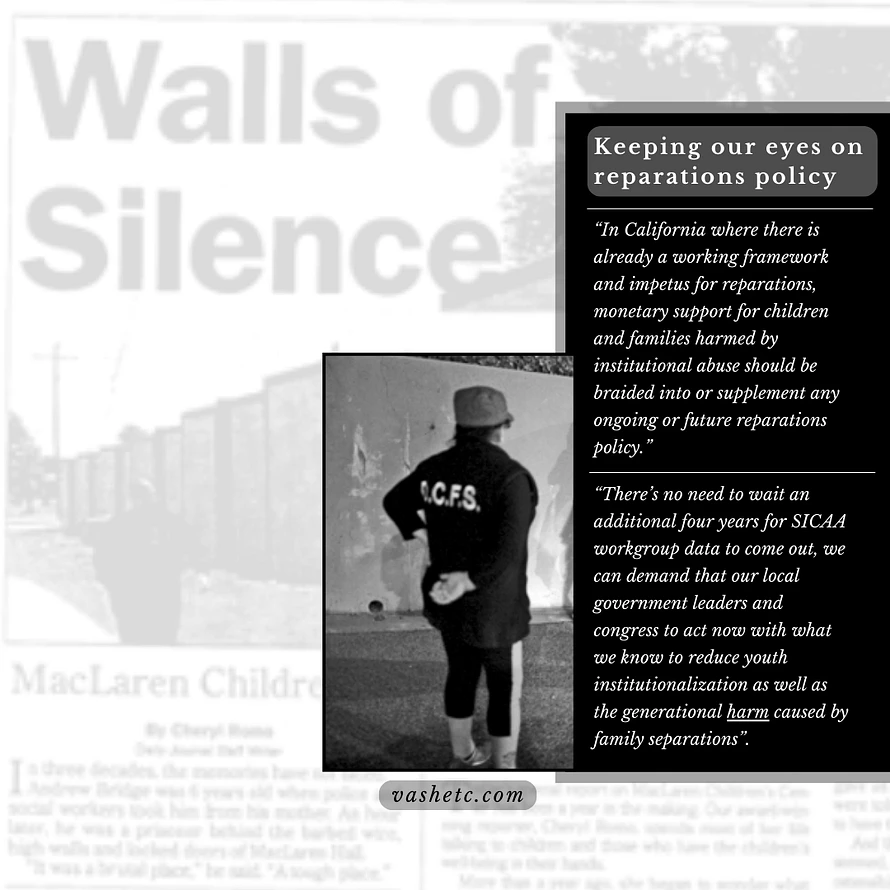Families harmed by institutional child abuse should receive reparations
 On December 24, 2024, President Biden signed The Stop Institutional Child Abuse Act, an accountability and transparency bill aimed at understanding the scope of harm caused to children receiving institutionalized treatment. The bill requires the formation of a federal working group, and the initiation of a study by the National Academies of Sciences, Engineering, and Medicine. Thanks to Paris Hiltons advocacy the bill has brought some renewed attention to the horrors of institutional violence, yet Black youth and families who remain most impacted by institutionalization and congregate care have been absent from recent SICAA press coverage. Centering the plight of Black youth and families can help direct swifter legislative action that addresses ongoing institutional violence and repairs the decades of harm already caused.
On December 24, 2024, President Biden signed The Stop Institutional Child Abuse Act, an accountability and transparency bill aimed at understanding the scope of harm caused to children receiving institutionalized treatment. The bill requires the formation of a federal working group, and the initiation of a study by the National Academies of Sciences, Engineering, and Medicine. Thanks to Paris Hiltons advocacy the bill has brought some renewed attention to the horrors of institutional violence, yet Black youth and families who remain most impacted by institutionalization and congregate care have been absent from recent SICAA press coverage. Centering the plight of Black youth and families can help direct swifter legislative action that addresses ongoing institutional violence and repairs the decades of harm already caused.
According to a Children’s Rights report, Black youth comprise about 13% of the US youth population but make up 23% of the foster care and 26% of the “total institutions and group care facilities” populations. Black disabled youth and youth who also identify as LGBTQ+ face compounded risk of institutionalization. Numerous studies show how harmful residential treatment is and how it may lead to further institutionalization, particularly for black youth. There’s no need to wait an additional four years for SICAA workgroup data to come out, we can demand that our local government leaders and congress to act now with what we know to reduce youth institutionalization as well as the generational harm caused by family separations. In jurisdictions like California where black youth were found to be three times more likely to spend time in foster care or experience a termination of parental rights when compared to white youth, it is imperative to act swiftly, especially if there’s bipartisan agreement over the significance of curtailing this form of abuse.
In California where there is already a working framework and impetus for reparations, monetary support for children and families harmed by institutional abuse should be braided into or supplement any ongoing or future reparations policy. California’s reparations task force and their respective grassroots partners use the United Nations five requirements of reparations which includes restitution, compensation, rehabilitation, satisfaction, and guarantee of non-repetition. Unfortunately transparency focused bills like SICAA often fail to meet any of these reparatory requirements and generally do not lead to any meaningful progress towards reparative action, especially for Black youth.
These federal legislation gaps are compounded by inadequate reparations policy at the state and county level, where the invisibility of Black youth sometimes continues. For example, the California Reparations Taskforce described the harms caused to the Black family in their reparations report, yet there has not been any recent legislation specifically focused on addressing the extensive harms caused by the “child welfare” system, including residential treatment centers or congregate care. Particularly notable is that child maltreatment reporting agencies are missing from the economic calculation created by the reparations task force, even though there is extensive data on Black family involvement in the system including foster care placement, congregate care placement, and data from complaints to the short term residential treatment placement ombudsman. Part of the reason Black youth are separated from their families disproportionately is because agencies use administrative data that contains proof of this history with the system. There is work to do on both the federal and local legislative fronts to ensure that youth and families harmed by residential treatment facilities are properly acknowledged and attended to.
There are several reparations frameworks for policymakers to choose from as outlined in the California reparations report, with direct cash being the priority for most community members. Advocates for family policing system abolition reparations across the country have used Canada’s Indian Residential Schools Settlement Agreement (IRSSA) as an example of what is possible for Black families in the US. The IRSSA compensated victims who were placed in residential government-funded boarding schools “for harms inflicted on generations of Indigenous children”. However parallel or similar legislation for Black families do not exist, or have not gained the traction that they deserve.
It’s imperative that we continue moving towards direct action based on the evidence we already have in hand. The recent attention on SICAA is a reminder that we can use this momentum to demand our policymakers to take direct steps to both prevent and repair harm. Although the legislative focus has been on ensuring that abuse does not happen in institutions, there should be parallel focus on compensating those who live with past harm every day. As made apparent by Hilton’s years long advocacy around SICAA, the consequences of institutional abuse are not one and done. As an organizer who used to work with mothers in Skid Row I saw the devastating effects of that families are impacted for generations by the the shattering of familial and community bonds, experiencing periods of severe stress and trauma, economic instability and limited economic opportunities, as well as loneliness and isolation. There is a need for repair for both individuals and the larger communities, which will require direct cash assistance, community resources, and the dismantling of harmful insitutuins and institutional practices. The passing of SICAA is a reminder of what is possible and what battles lie ahead for 2025.